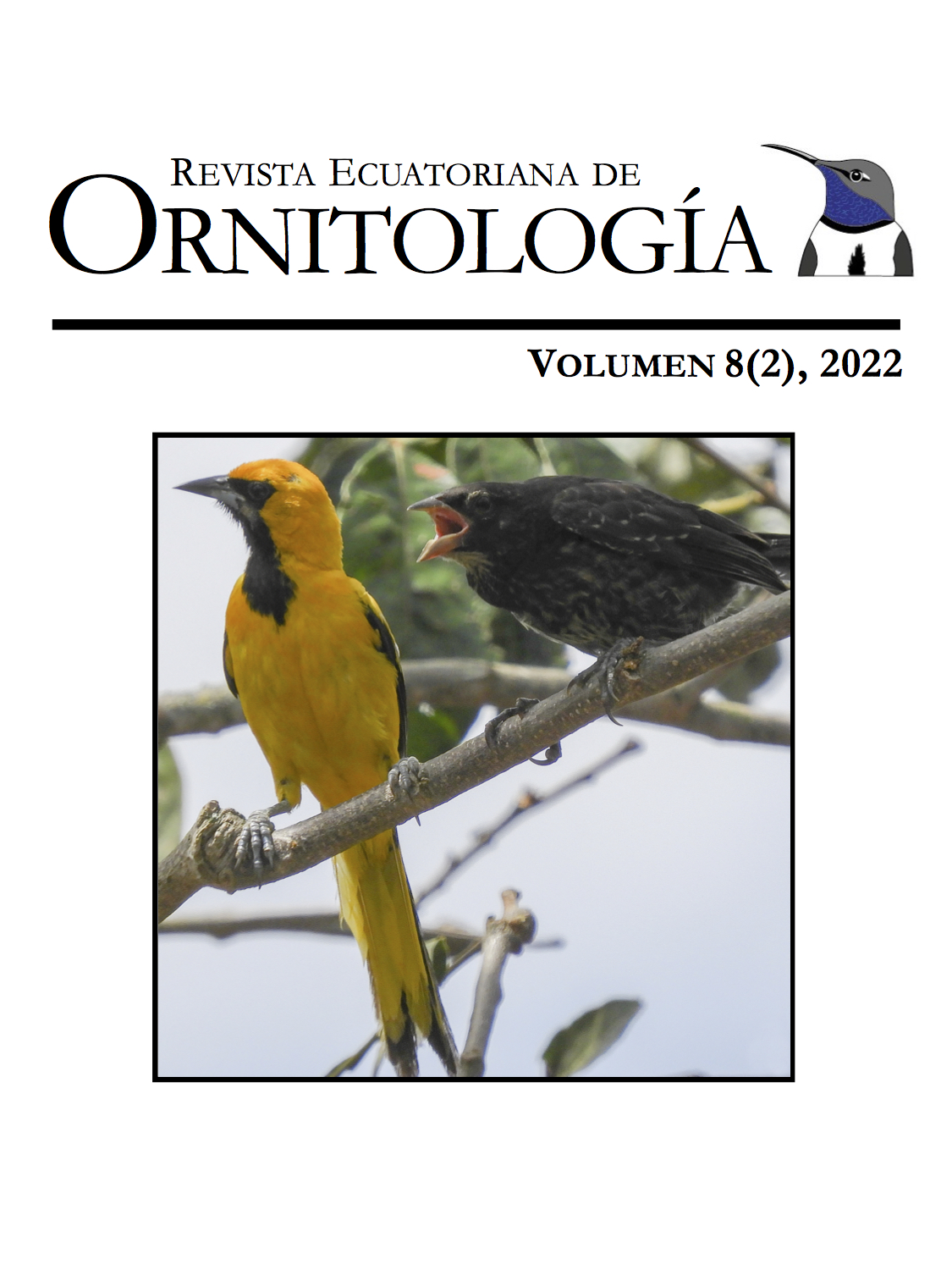DEPREDATION OF A SHINY COWBIRD Molothrus bonariensis BY A COMMON BOA (Boa constrictor) IN MANABÍ, ECUADOR
DOI:
https://doi.org/10.18272/reo.v8i2.2744Palabras clave:
Boa Común, Depredación, Manabí, Selección de Presa, Tordo BrillanteResumen
We present a sightseen of a juvenile Common Boa Boa constrictor preying on an individual of Shiny Cowbird Molothrus bonariensis. The event occurred in Manabí, Ecuador and lasted almost two hours since the attack started until the prey was completely swallowed and the Boa started to move.
Descargas
Citas
Card, D.C., Schield, D.R., Adams, R.H., Corbin, A.B., Perry, B.W., Andrew, A.L., Pasquesi, G.J.M., Smith, E.N., Jezkova, T., Boback, S.M., Booth, W. & Castoe, T.A. (2016). Phylogeographic and population genetic analyses reveal multiple species of Boa and independent origins of insular dwarfism. Molecular Phylogenetics and Evolution, 102, 104–116. DOI: https://doi.org/10.1016/j.ympev.2016.05.034
Crespo-Pérez, V., Pinto, C.M., Carrión, J.M., Jarrín-E, R.D., Poveda, C. & de Vries, T. (2016). The Shiny Cowbird, Molothrus bonariensis (Gmelin, 1789) (Aves: Icteridae), at 2,800 m in Quito, Ecuador. Biodiversity Data Journal, 4, https://bdj.pensoft.net/articles.php?id=8184
Lowther, P.E. (2018). Lists of victims and hosts of the parasitic cowbirds (Molothrus). Chicago, IL: The Field Museum. URL: https://www.fieldmuseum.org/sites/default/files/cowbird-hosts-05sep2018.pdf
Martínez-Morales, M.A., & Cuaron, A.D. (1999). Boa constrictor, an introduced predator threatening the endemic fauna on Cozumel Island, Mexico. Biodiversity and Conservation, 7, 957–963. DOI: https://link.springer.com/article/10.1023/A:1008815004072
Oppel, S., Schaefer, H.M., Schmidt, V., & Schröder, B. (2004). Habitat selection by the pale-headed brush-finch (Atlapetes pallidiceps) in southern Ecuador: Implications for conservation. Biological Conservation, 118(1), 33–40. DOI: https://doi.org/10.1016/j.biocon.2003.07.006
Quick, J.S., Reinert, H.K., Eric, R., & Odum, A. (2005). Recent occurrence and dietary habits of Boa constrictor on Aruba, Dutch West Indies. Journal of Herpetology, 39, 304–308. URL: https://www.herpconbio.org/Volume_16/Issue_1/Reinert_etal_2021.pdf
Reed, R.N., & Rodda, G.H. (2009). Giant constrictors: biological and management profiles and an establishment risk assessment for nine large species of pythons, anacondas, and the Boa constrictor (No. 2009-1202). Reston, Virginia: US Geological Survey. DOI: https://doi.org/10.3133/ofr20091202
Reinert, H.K., Leto, A.E., Tumaliuan, J.A., Jackrel, S., Lutterschmidt, W.I., Bushar, L.M., & Odum, R.A. (2021). A long-term dietary assessment of invasive Boa constrictor on Aruba. Herpetological Conservation & Biology, 16, 211–224. URL: https://jackrellab.biosci.ucsd.edu/wp-content/uploads/2021/11/Reinert_etal_HerpConBio_2021.pdf
Salvador, S. (2016). Registros de depredadores de huevos, pichones y volantones de aves de Argentina. Acta Zoológica Lilloana, 60, 136–147. URL: https://www.lillo.org.ar/journals/index.php/acta-zoologica-lilloana/article/view/93
Wiley, R.H., & Wiley, M.S. (1980) Spacing and timing in the nesting ecology of a tropical blackbird: comparison of populations in different environments. Ecological Monographs, 50, 153–178. DOI: https://doi.org/10.2307/1942477
Descargas
Publicado
Cómo citar
Número
Sección
Licencia
Derechos de autor 2022 Martín Carrera, Claudia Samuelsson, Cornelio Williams

Esta obra está bajo una licencia internacional Creative Commons Atribución-NoComercial 4.0.
Los autores que publiquen en la Revista Ecuatoriana de Ornitología aceptan los siguientes términos:
- Los autores/as conservarán sus derechos de autor y garantizarán a la revista el derecho de primera publicación de su obra, el cuál estará simultáneamente sujeto a la Licencia de Reconocimiento No Comercial de Creative Commons.
- Los autores/as podrán adoptar otros acuerdos de licencia no exclusiva de distribución de la versión de la obra publicada, pudiendo de esa forma publicarla en un volumen monográfico o reproducirla de otras formas, siempre que se indique la publicación inicial en esta revista.
- Se permite y se recomienda a los autores difundir su obra a través de Internet en su repositorio institucional, página web personal, o red social científica (como ResearchGate o Academia.edu).



